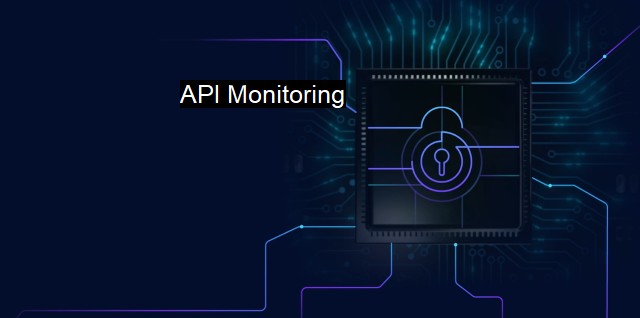What is API Monitoring?
Ensuring Cybersecurity through API Monitoring: Analyzing Communication Between Software Systems to Prevent Cyber Threats and Network Vulnerabilities
API monitoring refers to the process of examining Application Programming Interfaces (APIs) to assess their functional efficiency, security, reliability and accessibility. APIs are essentially powerful communication conduits that allow different software applications to interact, exchange data and functionalities seamlessly. APIs are integral to the operational efficiency of systems and networks. They facilitate a wide range of tasks, from enabling the interoperability of microservices to providing the backbone for modern applications and cybersecurity frameworks, thus making API monitoring an absolute necessity.In the context of cybersecurity and antivirus systems, API monitoring is critical to overall system protection and efficiency. Cybersecurity APIs could be tasked with anything from threat isolation and incident response, maintaining or updating system's antivirus, to full-fledged security automation. As such, robust API monitoring helps to ensure that cyber defense mechanisms are always up, running and effective.
One of the main benefits of API monitoring in these frameworks is the accelerated detection of security threats. For instance, a compromised API might signal a potential data breach in progress. Thus, API monitoring can increase the speed and efficacy of threat response, helping fend off cyber-attacks more effectively. An example of API functionality in response to threats includes the system sending an automatic notification to threat intelligence platforms that could then perform an immediate attack analysis, or triggering security protocols that help to limit the damage.
Secondly, monitoring APIs can also help pick up on vulnerabilities before they are exploited. Often times, APIs can present exploitable security flaws, such as coding errors or lack of encryption, which if undetected, could serve as entry points for attackers to infiltrate the system. Rigorous API monitoring can uncover these security loopholes in advance, enabling cybersecurity and antivirus professionals to address and fix them proactively.
Another way that API monitoring proves beneficial is through helping maintain system compliance. With ever-evolving regulatory requirements surrounding data protection, incorporating API monitoring into your cybersecurity strategy can enable a smoother alignment with standards. For instance, certain aspects of the General Data Protection Regulation (GDPR) specifically involve APIs – being able to demonstrate monitoring, logs, and well-managed APIs could assist with establishing compliance.
API performance monitoring offers insights into the overall performance and load capacity of the backend infrastructure. Performance failures and rate limits could potentially impact the optimal functionality of cybersecurity and antivirus systems, leaving them vulnerable to attacks. By identifying and rectifying these inefficiencies in time, API monitoring ensures that the backend architecture consistently supports the objectives of the cybersecurity framework.
It's also important to bear in mind that the process of API monitoring within cybersecurity configurations cannot be purely dependent on a set-it-and-forget-it strategy. Given the dynamic nature of cybersecurity threats, coupled with the ever-changing API ecosystem, an ongoing focus on monitoring, evaluating and refining API performance is key.
In the end, API monitoring isn’t just a matter of system upkeep; it is a proactive stance geared towards supporting cybersecurity and antivirus capabilities. And as the API landscape continues to evolve and expand, businesses and developers would do well to continue investing in robust, scalable API monitoring tools and practices that will ensure their cyber defenses remain not just strong, but efficient and compliant, for the long term.
To sum up, API monitoring is a powerful tool in both preserving and enhancing cybersecurity. From promptly identifying potential security breaches to preemptively uncovering system vulnerabilities and ensuring optimal performance, API monitoring cannot be underestimated and is here to stay to defend and maintain our cybersecurity systems.

API Monitoring FAQs
What is API monitoring?
API monitoring is the continuous process of observing and measuring the performance and behavior of APIs to detect any potential security issues, errors, or anomalies. It involves checking the availability, correctness, and responsiveness of APIs and ensuring that they conform to industry standards and compliance regulations.Why is API monitoring important for cybersecurity?
API monitoring plays a critical role in cybersecurity as APIs are a common attack vector for cybercriminals. By monitoring APIs, organizations can detect and prevent attacks like injection, cross-site scripting, and denial-of-service attacks. It also helps in identifying vulnerabilities, weaknesses, and suspicious activities that could lead to data breaches, malware infections, or other security incidents.What are the benefits of API monitoring?
The benefits of API monitoring include improved security, enhanced performance, better user experience, and increased uptime. API monitoring helps in identifying potential outages, reducing downtime, optimizing API performance, and providing insights into how APIs are used by consumers. It also enables proactive monitoring and troubleshooting, reducing the risk of data loss, system failures, or other issues.How does API monitoring relate to antivirus software?
API monitoring and antivirus software work together to protect against cyber threats. Antivirus software scans files, URLs, and email attachments for known malware, viruses, and other malicious content. In contrast, API monitoring focuses on detecting and preventing attacks on APIs, the underlying infrastructure, and applications. By combining both, organizations can provide comprehensive cybersecurity protection that covers various attack surfaces, including web applications and APIs.| | A | | | B | | | C | | | D | | | E | | | F | | | G | | | H | | | I | | | J | | | K | | | L | | | M | |
| | N | | | O | | | P | | | Q | | | R | | | S | | | T | | | U | | | V | | | W | | | X | | | Y | | | Z | |
| | 1 | | | 2 | | | 3 | | | 4 | | | 7 | | | 8 | | |||||||